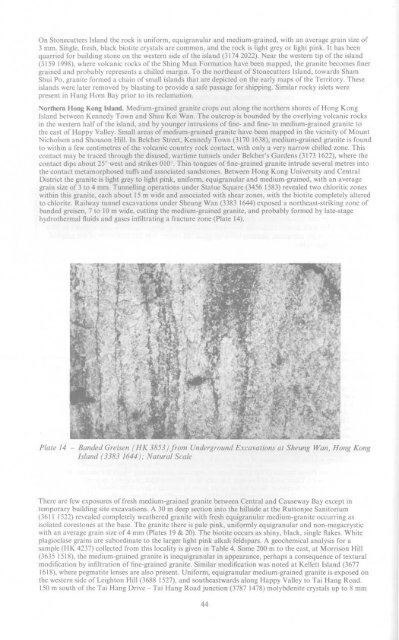Superficial Geology
Superficial Geology
Superficial Geology
Create successful ePaper yourself
Turn your PDF publications into a flip-book with our unique Google optimized e-Paper software.
On Stonecutters Island the rock is uniform, equigranular and medium-grained, with an average grain size of<br />
3 mm. Single, fresh, black biotite crystals are common, and the rock is light grey or light pink. It has been<br />
quarried for building stone on the western side of the island (3174 2022). Near the western tip of the island<br />
(3159 1998), where volcanic rocks of the Shing Mun Formation have been mapped, the granite becomes finer<br />
grained and probably represents a chilled margin. To the northeast of Stonecutters Island, towards Sham<br />
Shui Po, granite formed a chain of small islands that are depicted on the early maps of the Territory. These<br />
islands were later removed by blasting to provide a safe passage for shipping. Similar rocky islets were<br />
present in Hung Horn Bay prior to its reclamation.<br />
Northern Hong Kong Island. Medium-grained granite crops out along the northern shores of Hong Kong<br />
Island between Kennedy Town and Shau Kei Wan. The outcrop is bounded by the overlying volcanic rocks<br />
in the western half of the island, and by younger intrusions of fine- and fine- to medium-grained granite to<br />
the east of Happy Valley. Small areas of medium-grained granite have been mapped in the vicinity of Mount<br />
Nicholson and Shouson Hill. In Belcher Street, Kennedy Town (3170 1638), medium-grained granite is found<br />
to within a few centimetres of the volcanic country rock contact, with only a very narrow chilled zone. This<br />
contact may be traced through the disused, wartime tunnels under Belcher's Gardens (3173 1622), where the<br />
contact dips about 25° west and strikes 010°. Thin tongues of fine-grained granite intrude several metres into<br />
the contact metamorphosed tuffs and associated sandstones. Between Hong Kong University and Central<br />
District the granite is light grey to light pink, uniform, equigranular and medium-grained, with an average<br />
grain size of 3 to 4 mm. Tunnelling operations under Statue Square (3456 1583) revealed two chloritic zones<br />
within this granite, each about 15m wide and associated with shear zones, with the biotite completely altered<br />
to chlorite. Railway tunnel excavations under Sheung Wan (3383 1644) exposed a northeast-striking zone of<br />
banded greisen, 7 to 10m wide, cutting the medium-grained granite, and probably formed by late-stage<br />
hydrothermal fluids and gases infiltrating a fracture zone (Plate 14).<br />
"<br />
Plate 14 - Banded Greisen (HK 3853) from Underground Excavations at Sheung Wan, Hong Kong<br />
Island (3383 1644); Natural Scale<br />
There are few exposures of fresh medium-grained granite between Central and Causeway Bay except in<br />
temporary building site excavations. A 30 m deep section into the hillside at the Ruttonjee Sanitorium<br />
(3611 1522) revealed completely weathered granite with fresh equigranular medium-granite occurring as<br />
isolated corestones at the base. The granite there is pale pink, uniformly equigranular and non-megacrystic<br />
with an average grain size of 4 mm (Plates 19 & 20). The biotite occurs as shiny, black, single flakes. White<br />
plagioclase grains are subordinate to the larger light pink alkali feldspars. A geochemical analysis for a<br />
sample (HK 4237) collected from this locality is given in Table 4. Some 200 m to the east, at Morrison Hill<br />
(3635 1518), the medium-grained granite is inequigranular in appearance, perhaps a consequence of textural<br />
modification by infiltration of fine-grained granite. Similar modification was noted at Kellett Island (3677<br />
1618), where pegmatite lenses are also present. Uniform, equigranular medium-grained granite is exposed on<br />
the western side of Leighton Hill (3688 1527), and southeastwards along Happy Valley to Tai Hang Road.<br />
150 m south of the Tai Hang Drive - Tai Hang Road junction (3787 1478) molybdenite crystals up to 8 mm

















